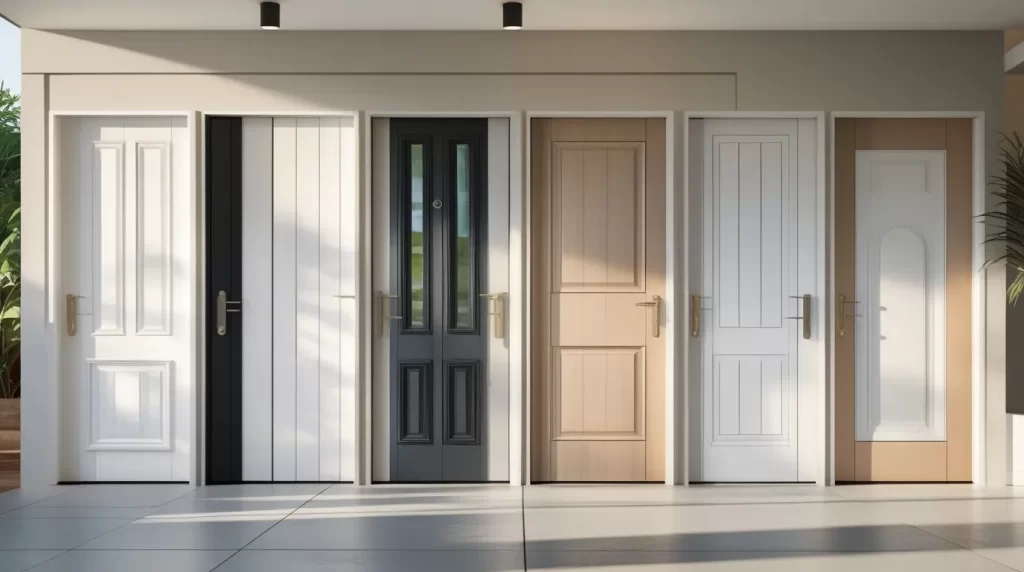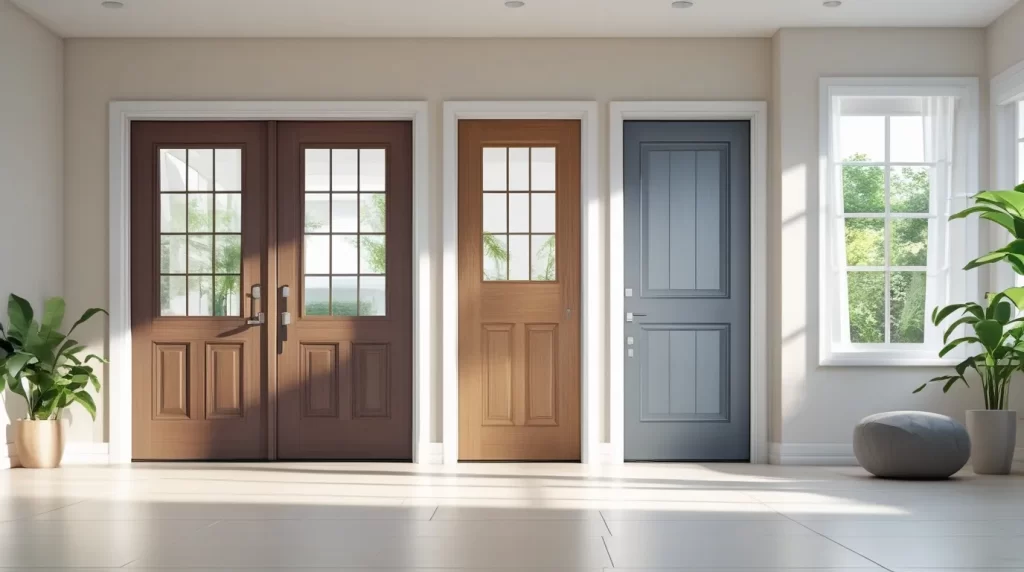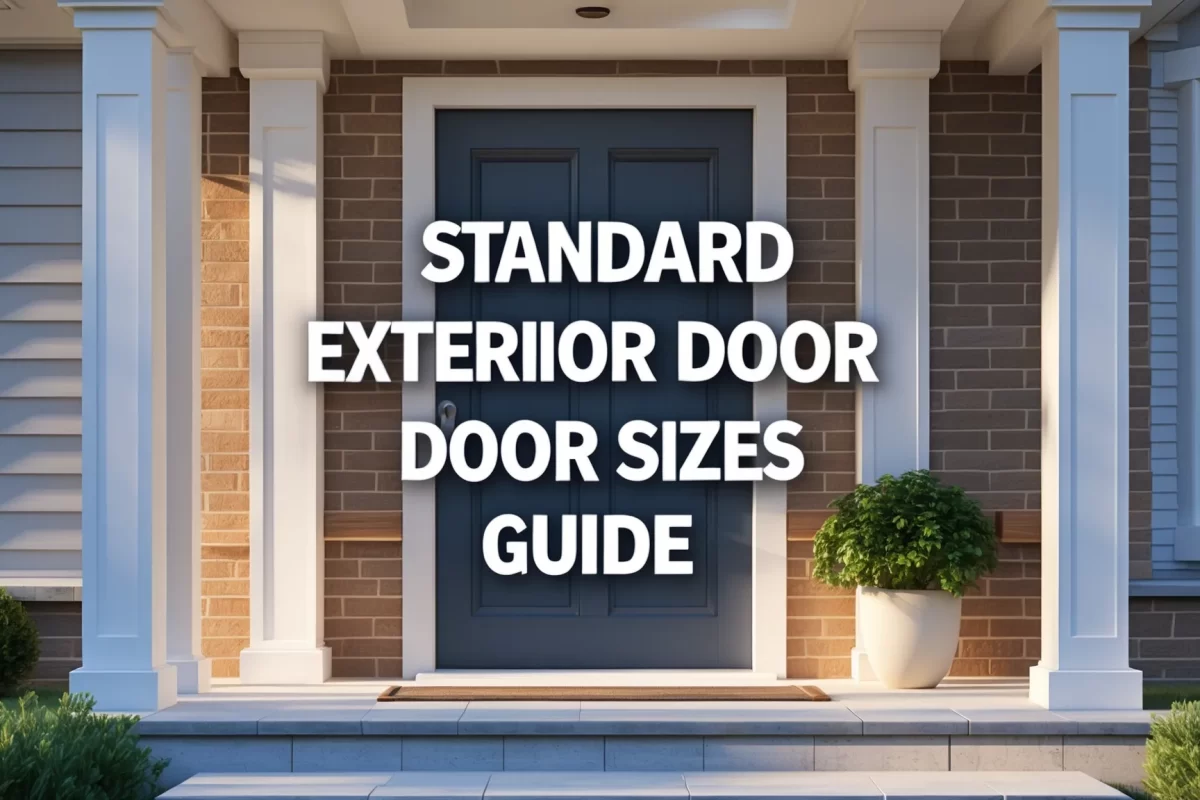When it comes to doors, size is more important than most people realize. The right size ensures safety, comfort, style, and efficiency. This detailed guide covers standard exterior door sizes, average entry door sizes, and common residential door dimensions. You’ll also find helpful charts, frame measurement details, and practical advice on choosing the right fit for your home. Whether you’re planning a remodel, replacing a front entry, or simply curious about measurements, this guide gives you everything you need to know.
Understanding Door Measurements: Why They Matter for Home Design
Many homeowners only notice door size when something goes wrong. Maybe furniture won’t fit through the entryway, or a draft keeps sneaking in around the edges. These issues are almost always connected to poor sizing. An entry door that’s too small feels cramped and unsafe, while one that’s too large may not align with your frame.
Door sizing also affects:
-
Energy efficiency Proper fit reduces heating and cooling loss.
-
Accessibility Wider doors help people with mobility devices.
-
Resale value A properly sized, modern entry adds value to your home.
This is why professional contractors stress accurate measurement before installation. Getting it right the first time avoids unnecessary repairs and replacements.
How Door Size Charts Help Homeowners Make the Right Choice

A door size chart works as a visual guide, showing the most common measurements for residential doors. Think of it like a map you know exactly where your options stand.
Why charts matter:
-
They help homeowners compare different widths and heights.
-
They simplify conversations with contractors.
-
They reduce mistakes when buying slabs or rehung units.
For example, if you’re unsure whether a 32-inch or 36-inch door is better, the chart highlights how each fits into standard construction. Instead of guessing, you have a clear starting point.
What Is the Standard Exterior Door Sizes: A Clear Explanation
The standard exterior door size in the United States is 36 inches wide and 80 inches tall. This measurement has stood the test of time because it balances safety, accessibility, and aesthetics. It is wide enough to allow furniture to pass through but still practical for most house frames.
Some homes, especially older ones, may feature 32-inch exterior doors, while newer luxury homes often include 96-inch-tall doors for added style. Double doors and custom builds also exist, but for most American homes, 36 by 80 inches remains the gold standard.
So, the clear answer to “what is the standard exterior door size” is: 36 inches by 80 inches.
Average Entry Door Size in Modern Homes
The average entry door size usually matches the standard but can vary slightly. Modern homes often lean toward taller or wider options, creating an elegant look at the front entrance.
Some average options include:
-
36 by 80 inches Still the most common.
-
36 by 84 inches A bit taller for a stronger presence.
-
42 by 96 inches Found in luxury homes with higher ceilings.
While these variations exist, most homeowners still choose the 36-inch option because it’s affordable, widely available, and practical. Larger doors often require custom frames and may increase costs significantly.
Exterior Door Size Chart: A Helpful Guide for Home Projects
To give you a clear reference, here’s a chart of common exterior door sizes:
| Door Width | Door Height | Typical Use | Notes |
|---|---|---|---|
| 30 inches | 80 inches | Side or back entrances | Narrow fit, less common for front doors |
| 32 inches | 80 inches | Secondary entry doors | Works for smaller houses or older builds |
| 34 inches | 80 inches | Transitional size | Less common but still used in some homes |
| 36 inches | 80 inches | Main entry doors | Standard size in most U.S. homes |
| 36 inches | 84 inches | Taller entry doors | Slightly taller, often custom |
| 36 inches | 96 inches | Modern homes | Dramatic presence, requires larger frame |
| 42 inches | 96 inches | Luxury builds | Wide and tall, less common |
This exterior door size chart is especially useful for comparing slabs, rehung doors, and frame requirements.
Residential Door Dimensions and Common Widths Explained

Residential door dimensions include both exterior and interior doors, but it’s important to know the difference.
-
Exterior doors Typically 36 by 80 inches, with variations for taller homes.
-
Interior doors Usually smaller, around 28 or 30 inches wide and 78 inches tall.
-
Back or utility doors Sometimes narrower, around 30–32 inches.
Residential door widths are designed for function. Exterior doors must allow large items to pass through, while interior doors prioritize space-saving. Knowing these differences prevents homeowners from mistakenly installing an interior-sized door in an exterior frame, which would weaken security.
Standard Residential Door Sizes: What Most Homes Use
Most homes follow predictable sizing standards. Standard residential door sizes allow builders to streamline production and homeowners to replace doors without expensive customization.
Typical standards:
-
Exterior doors: 36 by 80 inches.
-
Interior doors: 28–32 by 78 inches.
-
Sliding patio doors: Often wider, ranging from 60 to 72 inches.
Sticking with standard sizes makes shopping easier. If you ever sell your home, buyers expect doors that match common dimensions. That’s another reason most builders and contractors prefer not to deviate from these established standards.
Front Door Sizes Chart for Better Planning and Design
Your front door is more than just an entry it’s the centerpiece of your home’s exterior. A front door sizes chart helps balance design goals with practical needs.
-
30 by 80 inches Compact, rarely used for main entries.
-
32 by 80 inches Works for smaller entryways.
-
36 by 80 inches Standard for most homes.
-
36 by 96 inches Stylish and tall, found in newer builds.
-
42 by 96 inches Expansive and luxurious.
Planning with a chart also prevents mismatched proportions. For example, a 42-inch door may overwhelm a small cottage-style home, while a standard 36-inch door may look too modest on a large modern property.
Exterior Door Frame Sizes and Frame Dimensions Compared
A door is only as strong as its frame. Exterior door frame sizes must always be slightly larger than the slab to fit hinges and weatherproofing.
For example:
-
A 36 by 80 inch slab usually requires a 38 by 82 inch frame.
-
A 32 by 80 inch slab may need a 34 by 82 inch frame.
The exterior door frame dimensions also include the jamb depth, which can range from 4 9/16 inches to 6 9/16 inches, depending on wall thickness. A properly sized frame ensures smooth swinging, better insulation, and secure locking.
Standard Entry Door Measurements and Rehung Door Options

When reviewing standard entry door measurements, you’ll often see terms like slab and rehung.
-
Slab doors Only the panel itself, no frame included.
-
Rehung doors Come with the frame, hinges, and slab already attached.
Exterior rehung door sizes usually measure about 38 by 82 inches for a 36 by 80 inch slab. These are preferred by contractors because they reduce installation mistakes and ensure a tight fit. Rehung doors also come with weather-stripping already installed, improving efficiency and security.
International Door Sizes vs. U.S. Standards
It’s interesting to note that not all countries use the same sizing rules. For example:
-
In Europe, exterior doors often measure 32 by 82 inches.
-
In the UK, doors can be narrower, averaging 30 by 78 inches.
-
In Australia, 34 by 82 inches is common.
Compared to these, the U.S. standard of 36 by 80 inches strikes a balance between accessibility and design. Homeowners importing doors from other countries should be aware of these differences to avoid costly mistakes.
Safety and Accessibility Considerations for Exterior Doors
Beyond aesthetics, door size plays a key role in safety and accessibility. Wider doors make it easier for:
-
Wheelchairs and mobility devices to pass through.
-
Large furniture or appliances to be moved inside.
-
Emergency exits to function effectively.
According to accessibility guidelines, entry doors should be at least 36 inches wide, which matches the U.S. standard. Choosing narrower sizes may limit mobility and reduce convenience for families over time.
Maintenance and Replacement Tips for Exterior Doors
The lifespan of your door depends on both material and installation quality. Regardless of size, here are some tips:
-
Check weather-stripping every year.
-
Inspect hinges and frames for gaps.
-
Repaint or reseal wooden doors regularly.
-
Ensure locks align properly with the frame.
When replacing, always measure both the slab and the frame. Buying based only on slab size may lead to fitting issues.
Choosing the Right Fit with Repair Champions in Irvine, CA
Getting the right door size isn’t just about measurements it’s about expert guidance. At Repair Champions, we combine experience with trusted service to help homeowners select and install the right doors. Whether you’re sticking with a standard exterior door size or considering taller, wider options, we ensure a perfect fit. For homeowners in Irvine, CA, our team is here to make the process simple, professional, and stress-free.
Conclusion
Doors connect the inside and outside of your home, but their sizes determine how well they perform. The standard exterior door size of 36 by 80 inches works for most homes, balancing safety, energy use, and style. Larger or smaller options exist, but knowing the standards saves time and money. With this guide, you’ve learned about charts, residential dimensions, frame measurements, and pre hung options. For expert help, trust Repair Champions to deliver the right fit for your home.
If you’re ready to upgrade your home with the perfect door, contact us today to get started.













